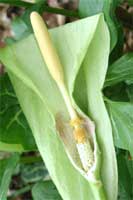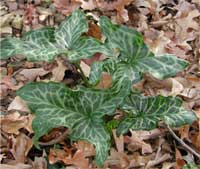Resource Library
Plant of the Week: Italian Arum
The University of Arkansas System Division of Agriculture does not promote, support or recommend plants featured in "Plant of the Week." Please consult your local Extension office for plants suitable for your region.
Plant of the Week
Italian Arum
Latin: Arum italicum

When I first saw Italian arum growing beside a Fayetteville home one winter day, I thought I had discovered a real rarity -- a houseplant that would survive the cold.
Since that first encounter many years ago, I’ve learned to appreciate this delightful little plant for its many charms, even though it’s no houseplant.
Italian arum (Arum italicum) is a member of the large philodendron family and makes a colorful addition to our winter gardens. As its name suggests, it’s a Mediterranean plant but with a remarkably wide natural range from Turkey to North Africa. It’s winter hardy through most of zone 6.
This cold hardy arum overwinters by means of a starchy corm that can reach 2 inches in diameter. Gerrard in his 1633 herbal tells us that a fine white laundry starch can be made from these tubers but it’s “most hurtful to the hands of the Laundresse that hath the handling of it.” Calcium oxalate crystals are common in many aroids and cause adverse skin reactions and tissue inflammation, especially if exposed to soft tissues.
In the fall these corms send up 6-inch long arrowhead (hastate) shaped leaves on foot-long petioles. The leaves are deep green with the veins marked with wide bands of gray-green. Though delicate looking, these leaves survive winter freezes, ice and snow, only dying away as the first hot days of summer arrive.
Flowers appear in May as erect, foot-long greenish-white spathes that stick above the foliage. Unlike many aroids with bizarre but beautiful blooms, Italian arum has a rolled, floppy spathe with little going for it in the beauty department. But, like all things in the natural world, they are very interesting.
First, aroid flowers are not flowers at all but an inflorescence - a cluster of individual flowers. The showy portion of the inflorescence, the spathe, is a modified leaf. The reproductive portion of the flower, the spadix, is a club-shaped affair with several distinct parts.
The dull yellow uppermost part is called the spadix-appendix and is 2 to 3 inches long. Its purpose is to attract attention amongst beetles and flies that will aid in pollination. Some aroid flowers smell like dead meat to attract pollinators; arums take a different approach - they smell like feces. One of the old names for this plant is “priest’s pintle,” an off-color comparative anatomy lesson between the male physique and this portion of the spathe.

Insects that enter the rolled spathe are funneled downward into the flower past a series of hairlike segments that trap the insect in the inflated tube of the inflorescence. There they fertilize female flowers on the lower portion of the spadix. The female flowers are receptive to pollen before the male stamens mature, thus helping ensure cross pollination. The stamens are on the spadix column above the pearl white female flowers.
After the pollinator has spent a day or two inside the flower, the stamens release pollen as they mature and the hairlike segments wither. The insect escapes to repeat the process with other nearby flowers. Soon after pollination, the foliage begins to die and the fruit ripens. The fruit is a bright red 3-inch cluster of peanut sized berries on a foot long stem. These are sold in the florist trade as cut “flowers.”
Italian arums are easy to grow in the garden. Any soil seems to work, but they grow faster in fertile, well drained sites. They’re most often grown in the deciduous woodland garden but do fine in full sun. If you wish to increase the size of the colony, divide in the summer during their dormant season. Once established, they seem almost indestructible.
By: Gerald Klingaman, retired
Extension Horticulturist - Ornamentals
Extension News - February 10, 2006
The University of Arkansas System Division of Agriculture does not maintain lists of retail outlets where these plants can be purchased. Please check your local nursery or other retail outlets to ask about the availability of these plants for your growing area.